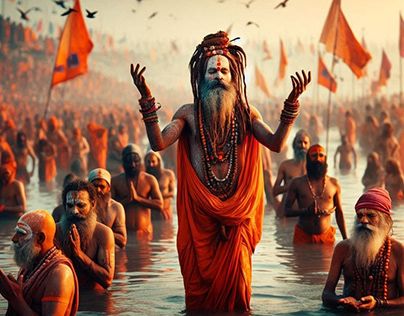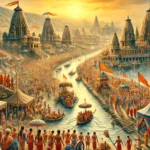Kumbh Mela Explained: Its Mythology, History, Astrology, and Why Millions Peoples are attracted to It
“Kumbh Mela Explained” The Kumbh Mela is one of the world’s largest and most significant religious gatherings, drawing millions of devotees from all over the globe. Held at four major locations in India—Prayagraj (Allahabad), Haridwar, Ujjain, and Nashik—it is a celebration of faith, devotion, and purification. But what makes this festival so extraordinary? Let’s explore its mythology, history, astrology, and the reasons why people from diverse backgrounds flock to it.
1. The Mythological Origin: Kumbh Mela Explained
The roots of the Kumbh Mela lie in Hindu mythology, particularly the story of the Samudra Manthan or the Churning of the Ocean. According to the myth, the gods and demons came together to churn the ocean in search of the nectar of immortality, called amrita. As the churning progressed, the ocean became tumultuous, and a pot, or Kumbh, of amrita surfaced. During the struggle for the pot, drops of the nectar fell at four specific places: Prayagraj, Haridwar, Ujjain, and Nashik. These locations became the sites for the Kumbh Mela, with Prayagraj being the host of the most significant Maha Kumbh every 12 years.
In this mythological context, the Kumbh Mela represents the quest for immortality and spiritual purification, as bathing in the sacred waters of these sites is believed to cleanse one’s sins and offer the promise of moksha (liberation from the cycle of birth and rebirth).
2. Historical Evolution: Kumbh Mela Explained
The Kumbh Mela has ancient roots in Hindu history, with references to it found in texts like the Mahabharata and the Puranas, which highlight its importance as a time for spiritual purification and rituals. The earliest mentions of the Kumbh Mela suggest that it was a much smaller, localized event. Over time, it grew into the grand spectacle that it is today, with millions of people gathering to take a holy dip in the river confluences, attend religious discourses, and partake in cultural rituals.
Historically, the Kumbh Mela has served as a platform for social cohesion and spiritual unity, transcending regional and sectarian boundaries. The festival often attracts not only religious devotees but also saints, yogis, and ascetics from various parts of India, contributing to the festival’s rich spiritual and cultural diversity.
3. Astrology and Astronomical Significance: Kumbh Mela Explained
The timing of the Kumbh Mela is deeply tied to astrology. The Mela is held when the planet Jupiter (Guru) enters the zodiac sign of Aries or Taurus, and the Sun and Moon align in a way that creates favorable conditions for spiritual purification. This alignment occurs once every 12 years, which is why the Maha Kumbh is celebrated only once every 12 years at each location.
Astrologically, this combination is said to generate an energy field that enhances spiritual awakening, making it the ideal moment for bathing in the sacred rivers. The Triveni Sangam at Prayagraj, where the Ganges, Yamuna, and the mythic Saraswati rivers meet, is considered the holiest spot for this purification ritual. Bathing at this confluence during the auspicious days of the Kumbh Mela is believed to wash away accumulated sins and offer liberation from the cycle of rebirth.
4. Why Millions Peoples are attracted to it; Kumbh Mela Explained
The draw of the Kumbh Mela is not just religious—it is also deeply personal, social, and cultural. Here are the main reasons why millions of people converge at Kumbh Mela sites:
a. Spiritual Cleansing and Liberation (Moksha)
For Hindus, the primary reason to attend the Kumbh Mela is to bathe in the holy river and cleanse oneself of sins. It is believed that the act of bathing during the Mela leads to spiritual purification and liberation (moksha) from the cycle of birth and death. Many devotees believe this is their once-in-a-lifetime opportunity to attain nirvana.
b. Collective Spiritual Experience
The Kumbh Mela provides a rare and intense spiritual experience. The vast congregation of people creates an environment charged with collective spiritual energy. The chanting of sacred mantras, the presence of holy men (like Naga Sadhus), and the devotional atmosphere all contribute to a sense of shared spiritual awakening.
c. Cultural and Religious Unity
Though the festival is primarily Hindu, people from all walks of life, including different religions and cultures, attend the event. The Kumbh Mela fosters a sense of unity in diversity, where people of different backgrounds come together to celebrate a common spiritual cause. The festival serves as a vivid reminder of the collective nature of spirituality and the power of faith in bridging human differences.
d. Pilgrimage and Tradition
For many, attending the Kumbh Mela is a tradition passed down through generations. It is often viewed as a pilgrimage, where individuals make a journey of devotion to seek blessings, improve their lives, and fulfill vows made to deities. For older generations, the Kumbh Mela represents a family and cultural tradition that holds deep emotional and spiritual significance.
e. Social Interaction and Community
The Kumbh Mela is not just about spiritual practices but also a celebration of community. Pilgrims often travel in groups, meet with relatives, and engage in communal activities, such as satsangs (spiritual discourses) and bhandaras (free meals). It offers an opportunity to reconnect with friends and family while strengthening the bonds of community.
5. The Rituals and Significance; Kumbh Mela Explained
While the main highlight of the Kumbh Mela is the ritual bath, the festival is also a time for spiritual teachings, religious discourses, and religious ceremonies. The most revered participants are the Naga Sadhus, ascetics who march in processions, usually unclad or wearing minimal clothing, in a display of renunciation and spiritual devotion. The Mela also sees the recitation of holy texts, performances of devotional music, and the offering of prayers to the river deities.
At its heart, the Kumbh Mela is a celebration of faith, purification, and the collective human journey towards spiritual awakening.
Conclusion: Kumbh Mela Explained
The Kumbh Mela is more than just a religious event; it is a spiritual phenomenon that draws millions of people in search of purification, divine blessings, and personal transformation. Rooted in ancient mythology, astrology, and religious practices, the festival continues to captivate and inspire devotees from all around the world. Whether seeking moksha, the unity of community, or a connection to India’s ancient traditions, the Kumbh Mela remains a vital and enduring symbol of spiritual devotion and the power of faith.










